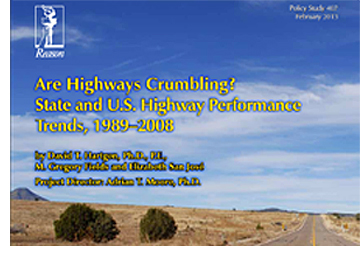
Condition of nation's highways has improved last two decades
“Are Highways Crumbling? State and U.S. Highway Performance Trends, 1989-2008; David T. Hartgen, M. Gregory Fields and Elizabeth San Jose; project director: Adrian T. Moore
Introduction:
Many reports and numerous media articles claim that the nation’s highway infrastructure is “crumbling.” For example, the American Society of Civil Engineers assigned an overall D grade to the nation’s infrastructure (which includes waste, water, aviation, levee and transit systems, in addition to highways and bridges) and estimated that it would take a $2.2 trillion investment to bring it into a “state of good repair.”
 A New York-New Jersey-Connecticut region planning organization suggests the region would have a “third-world” infrastructure within a few decades if nothing is done. And President Obama says that “crumbling” roads, bridges, airports and rail lines are hindering U.S. economic growth.
A New York-New Jersey-Connecticut region planning organization suggests the region would have a “third-world” infrastructure within a few decades if nothing is done. And President Obama says that “crumbling” roads, bridges, airports and rail lines are hindering U.S. economic growth.
Conventional wisdom holds that our highways and bridges are in a sorry state of condition. But is this conventional wisdom correct? Other studies paint a mixed picture. In its 2008 report to Congress on the condition of the transportation infrastructure, U.S. DOT notes that from 1997 to 2006, the physical condition of the National Highway System (and its bridges) actually improved, but urban and lower-class road systems did not fare quite as well.
Intercity, rural and small urban roads generally improved in condition while those in urban areas experienced some declines. The U.S. DOT report also noted improvements in fatality and injury rates but an increase in the amount of travel during congested conditions. Other studies note increasing highway repair needs as the basis for concerns about flagging revenue sources, but say little about whether the system is improving over time or how good it should be.
The primary sources for most hard data on the condition of roads and bridges are the Highway Performance Monitoring System, the National Bridge Inventory, the Fatal Accident Reporting System, and the Texas Transportation Institute’s reports on urban congestion.9 Each has its limitations and covers only a portion of its topic. The National Bridge Inventory is the most complete, reporting bridge condition and sufficiency data for all bridges since the 1970s. The Fatal Accident Reporting System reports only fatal accidents, not injuries or property-damage accidents.
The TTI reports cover only the larger cities and only the higher-class roads. The Highway Performance Monitoring System also covers higher road classes but misses all local roads. In spite of these shortcomings, these databases are sufficient to provide a high-level (but necessarily incomplete) picture of performance trends.
This report uses these sources but recognizes that the findings are therefore necessarily incomplete.
Published 3-1-13